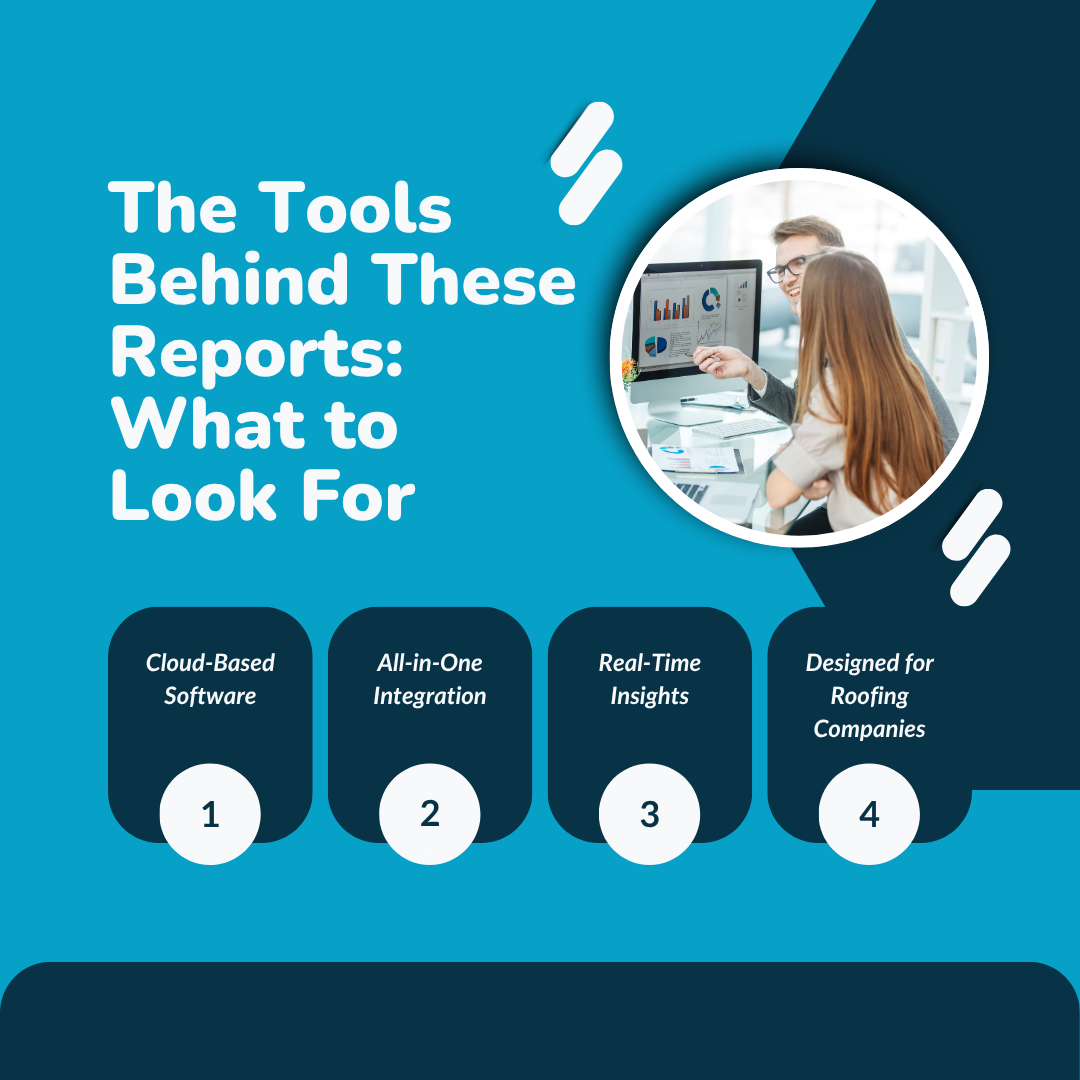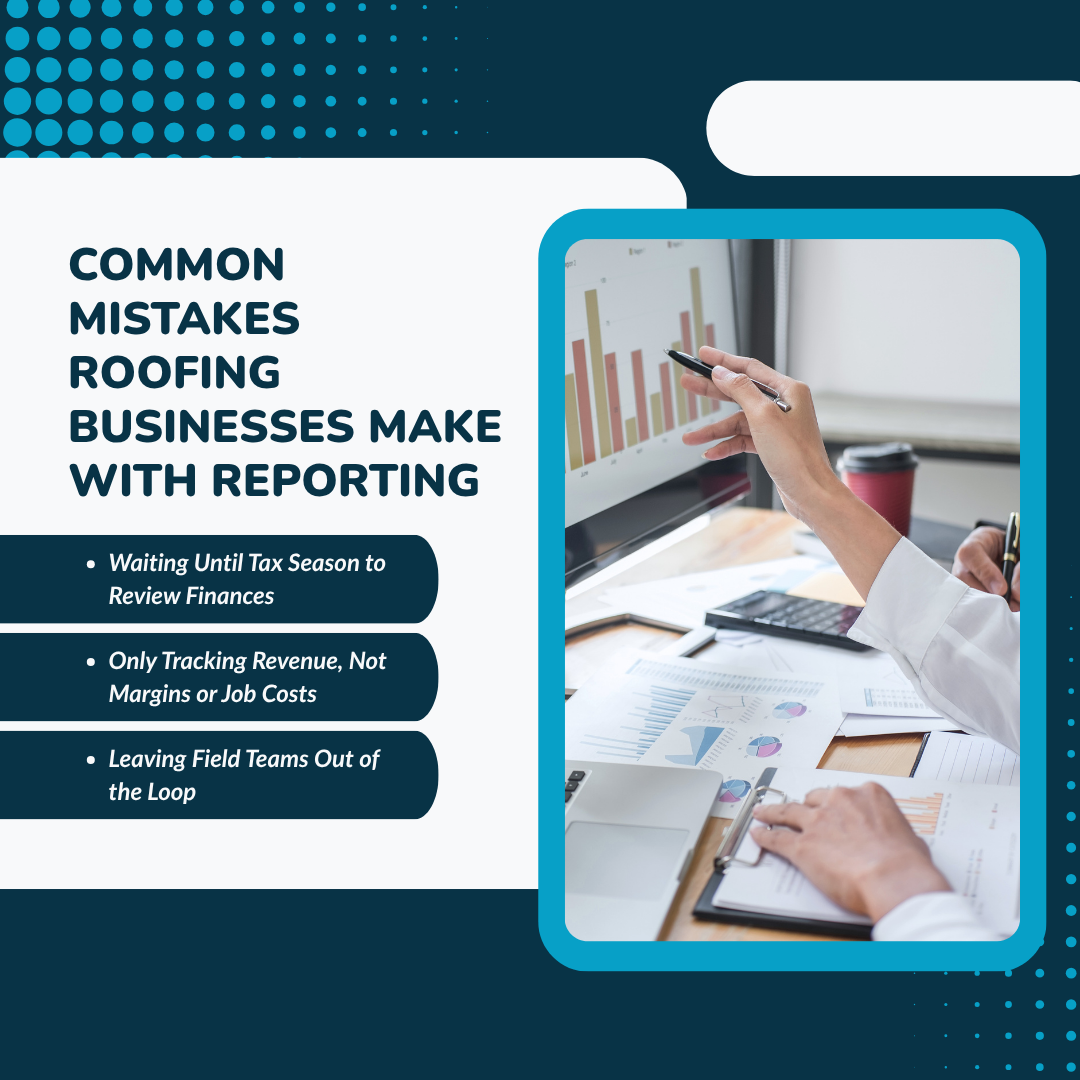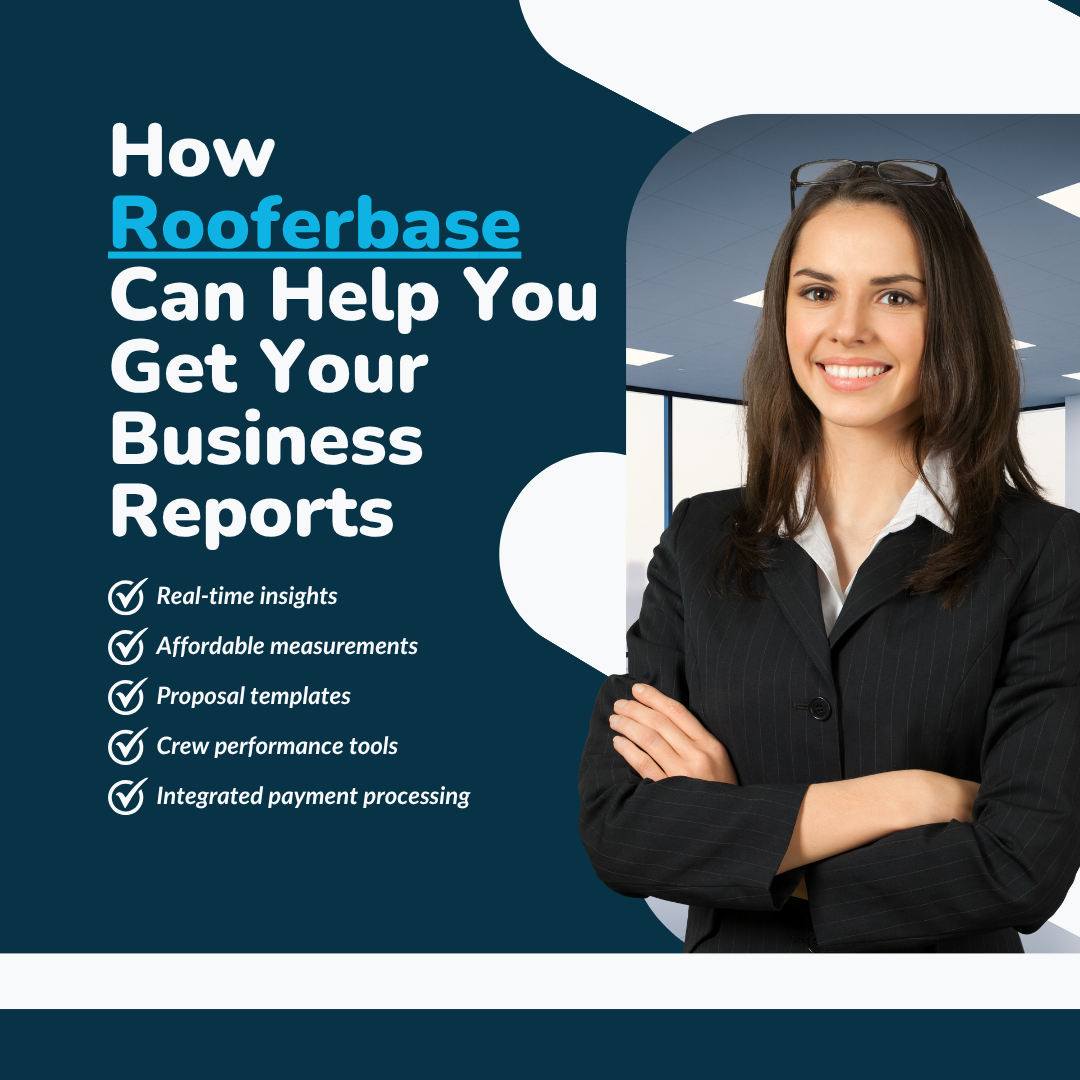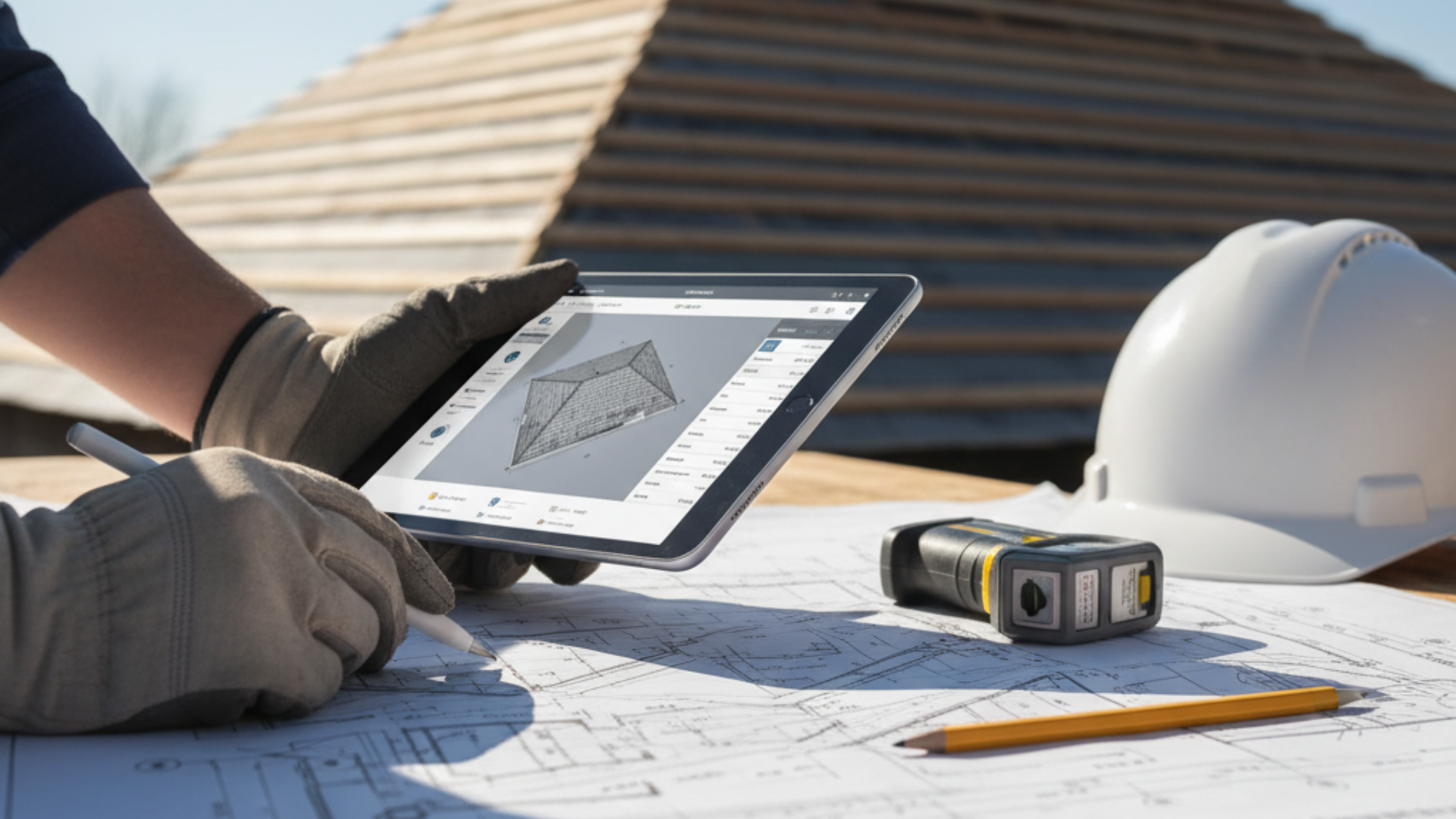July 8, 2025
Audio overview: Listen & Learn
Running a roofing business in 2025 means more than showing up to job sites and closing deals.
It means understanding where your money is going, how your team is performing, and what customers really think about your service.
In a rapidly evolving industry with digital estimating tools, increasing metal roofing material costs, and higher customer expectations, tracking the correct reports is crucial for survival.
Think of reports as both the rear-view mirror and the GPS of your business. They show you what’s worked, what hasn’t, and where you need to steer next.
2025 Roofing Business Reports You Can’t Ignore
Did you know? The roofing market is projected to grow from USD 143.86 billion in 2025 to USD 185.92 billion by 2032, with a compound annual growth rate (CAGR) of
3.6% over this period.
The roofing industry is evolving. Faster quoting, rising material costs, customer-first reputation pressures, and high expectations for professional proposals are pushing
contractors to work smarter. Data is no longer optional. It’s your ultimate competitive edge.
So, what reports do you need to track? Let’s break it down in the following blog.
Key Takeaways
- Roofing business reports are great tools that help you make smarter, data-informed decisions, making your business more efficient.
- They reveal what’s profitable, what’s leaking money, and what your customers are really experiencing.
- These are not just spreadsheets; they are your roadmap to business growth.
What Are Roofing Business Reports, and Why Should You Care?
A Quick Illustrative Story to Kick Off:
A small metal roofing contractor in North Carolina was struggling to break even. He didn’t realize that while sales looked great on paper, job profitability was slipping due to untracked material overruns. Once he started tracking three core reports (Job Profitability, Estimate vs Actual, and Customer Feedback), his business turned around in under 6 months. No gimmicks. Just data correctly.
Roofing business reports are more than just spreadsheets; they’re the foundation of how smart contractors run their operations today.
Whether you’re handling roof replacement projects, quoting residential homeowners, or managing teams across multiple locations, these reports help you stay up to date and make better decisions quickly.
Why Do They Matter?
They pull real-time data from you:
- Roofing CRM
- Roofing estimating software
- Accounting software
- Project management tools
This means you see the full picture, from job costs and crew performance to customer feedback and sales trends, all in one place.
Read more about Do Roofing Contractors Need Specialized Roofing Software?
Built for the Real Roofing Space
Reports help answer questions like:
- Are your roof measurements accurate enough to provide a confident quote?
- Are you ordering too many materials or not enough?
- Are you receiving payments on time? How do you remind customers about their payments?
They also keep your pricing in check, helping you deliver accurate estimates and build trust with every proposal.
Why Should You Care?
In today’s competitive roofing space, where homeowners expect fast service and fair pricing, reports are your edge.
They help you:
- Deliver better roofing sales experiences
- Run smoother roofing projects
- Track every dollar and decision
And grow into one of your area's best roofing companies.
With all the tools in one place, reporting isn’t just a back-office task; it’s your business’s growth engine.
Top Roofing Business Reports You Should Be Tracking in 2025
Are you tracking the right numbers, or just guessing? In a roofing business, what you don’t measure can cost you real money. Let’s break down the essential reports that successful contractors rely on in 2025.
1. Job Profitability Report
- What it shows: Project-wise breakdown of cost vs revenue.
- Why it matters: You may have closed a big deal, but was it worth it?
- Tip: Track labor and materials separately. Metal roofing costs are volatile.
2. Estimate vs Actual Report
- Purpose: Measures quoting accuracy.
- Benefits: Helps you find where you’re overpromising or underestimating.
- Tools: Fast and accurate measurements, paired with estimating software, make this process seamless.
3. Customer Experience and Service Report
- Why care? In 2025, reviews and referrals will drive more deals than cold outreach.
- Track: Support tickets, ratings, repeat customer percentage.
- Bonus: CRM integrations automate the follow-ups.
4. Material Ordering and Usage Report
- With ABC Supply or SRS Distribution, you can connect your inventory system.
- Why it helps: Prevents overordering and delays, saving time and money.
5. Sales Pipeline and Lead Conversion Report
- What to track: From canvassing efforts to closing deals.
- Why it’s powerful: It tells you which sales reps are closing, what marketing works, and where deals drop off.
6. Crew Productivity Report
- Insights: Man-hours, task completion, timelines.
- Use case: Reward top crews, schedule better, and reduce idle time on job sites.
7. Financing and Cash Flow Report
- Vital for managing payments, financing options, and staying cash-positive.
- Be aware of potential delays in customer payments and project bottlenecks.
8. Accounting and Tax Reports
- Includes P&L summaries, balance sheets, and payroll tracking.
- Why important: Avoid end-of-year surprises. Stay compliant. Plan smarter.
The Tools Behind These Reports: What to Look For

If you’re still bouncing between spreadsheets, email threads, WhatsApp chats, and a whiteboard in the office, there’s a better way.
In 2025, modern roofing companies are utilizing centralized, cloud-based platforms that consolidate all key elements in one place: estimates, sales, payments, crews, and financials. And no, you don’t need to be “techy” to use them.
Here’s what to look for when choosing the right tools to help you track, manage, and grow:
1. Cloud-Based Software (Mobile-Friendly is Non-Negotiable)
You’re always on the move, site visits, customer calls, and material pickups. Your business data should move with you.
- Access project data, reports, and updates from your phone or tablet.
- Log job site progress or upload documents in real-time.
- Never wait to update a spreadsheet once you return to the office.
Look for Cloud tools with dedicated mobile apps or responsive dashboards.
2. All-in-One Integration (No More Tab Chaos)
Your estimating software, CRM, and accounting tools should work together, not in silos.
- Create a proposal, send it to the customer, and track their approval without switching apps.
- View labor hours, material usage, and job status from a single dashboard.
- Sync payments and invoices with your bookkeeping software.
Look for A single platform where all your tools talk to each other automatically.
3. Real-Time Insights (So You're Always in Control)
Reports are only helpful if they’re up to date. Real-time insights help you spot issues before they become problems.
- Track job profitability as the project progresses.
- Receive alerts if labor costs increase or materials exceed the budget.
- Monitor your sales pipeline and track daily lead conversions.
Look for Dashboards that update live and can send alerts or summaries to your phone or email.
4. Designed for Roofing Companies (Not Just General Construction)
You don’t need a one-size-fits-all solution. You need something built for roofing workflows.
- Pre-built templates for roof measurements, metal roofing orders, and roof replacement quotes
- Scheduling tools optimized for crews working at multiple sites
- Features like integrated financing, credit card payments, and proposal templates
Look for Roofing-specific software, not a generic project management tool that you have to customize from scratch.
Platforms like Rooferbase bring everything into one clean, easy-to-use space. From the office staff to the field crew to the owner, everyone stays in sync.
Before choosing any tool, ask yourself:
> “Can my team learn this in a day and start seeing value in a week?”
If the answer is yes, you're on the right path.
Must read: Best Roofing CRM Software for 2025 | Simplify Your Business
How Often Should You Check These Reports?
| Report Type | Recommended Frequency |
|---|---|
| Job Profitability | Weekly |
| Cash Flow | Weekly |
| Customer Experience | Monthly |
| Tax Reports | Monthly / Quarterly |
| Crew Productivity | Weekly |
| Material Usage | Weekly |
| Sales Pipeline | Weekly |
Utilize automated dashboards and alerts to stay on top of numbers without getting overwhelmed.
Common Mistakes Roofing Businesses Make With Reporting

Even the most skilled roofing contractors can overlook key financial habits that quietly drain profits. Here are some of the most common missteps and why they matter:
1. Waiting Until Tax Season to Review Finances
If you only look at your books once a year, you're not running your business; you're reacting to it. Delayed financial reviews often conceal cash flow problems, missed payments, and unprofitable jobs that could have been corrected months earlier.
2. Only Tracking Revenue, Not Margins or Job Costs
It’s easy to feel good seeing big job totals on the board. But without tracking labor, material, and overhead costs, you're blind to which jobs are actually making money. A high-revenue project can still lose you money if your margins are too thin.
3. Leaving Field Teams Out of the Loop
Your crew leaders and site managers hold valuable insights. Not involving them in reviewing job timelines, productivity reports, or material usage misses out on honest feedback and leads to repeating the same mistakes.
80% of roofing contractors never make it to their third year, and 96% close down within five years. Poor financial management, often due to not tracking or reviewing business reports, is a primary reason for this high failure rate (source)
Bottom line: It’s not about more data, it’s about the right data and the right people reviewing it. Avoid these traps and turn your reports into a real-time decision-making tool, not just a paperwork formality
Additionally, check out Best Roofing Software 2025 – Tools to Increase Speed and Sales
How Rooferbase Can Help You Get Your Business Reports

Rooferbase is built for contractors. We bring your estimates, CRM, job tracking, customer experience, and accounting into a single dashboard.
You get:
- Project management tools
- Affordable measurements
- Proposal templates
- Crew performance tools
- Integrated payment processing
- Analytics and Reporting
All in one platform.
Rooferbase enables businesses to track job performance, sales metrics, and financial insights, analyze team productivity, and generate automated reports for accounting,
payroll, and financial planning.
Closing Thoughts: Make Reporting a Habit, Not a Hassle
Business reports don’t have to be overwhelming.
They should feel like your team’s GPS, showing what’s working, where you’re headed, and what’s worth improving.
With a smart digital toolbox like Rooferbase, you can make faster decisions, book more jobs, and build a roofing business that grows without chaos.
About Rooferbase
Want to see how these reports look in real life?
Explore Rooferbase today and see how your data can work for you. Book a Demo Now!
FAQs
Q1. What is the best CRM for the roofing industry?
Look for CRMs that integrate with your estimating and accounting tools. Software such as Rooferbase is explicitly designed for roofing pros.
Q2. How much does roofing software cost?
A: Prices vary, but modern cloud-based tools can start as low as $29/month and go up based on features and team size.
Q3. Why do Roofing companies use data-driven decisions to boost profitability?
A data-driven approach helps roofing companies optimize operations, improve customer satisfaction, and stay competitive. Using data analytics and digital tools, they increase efficiency, find cost savings, refine pricing, and boost revenue and profits.






